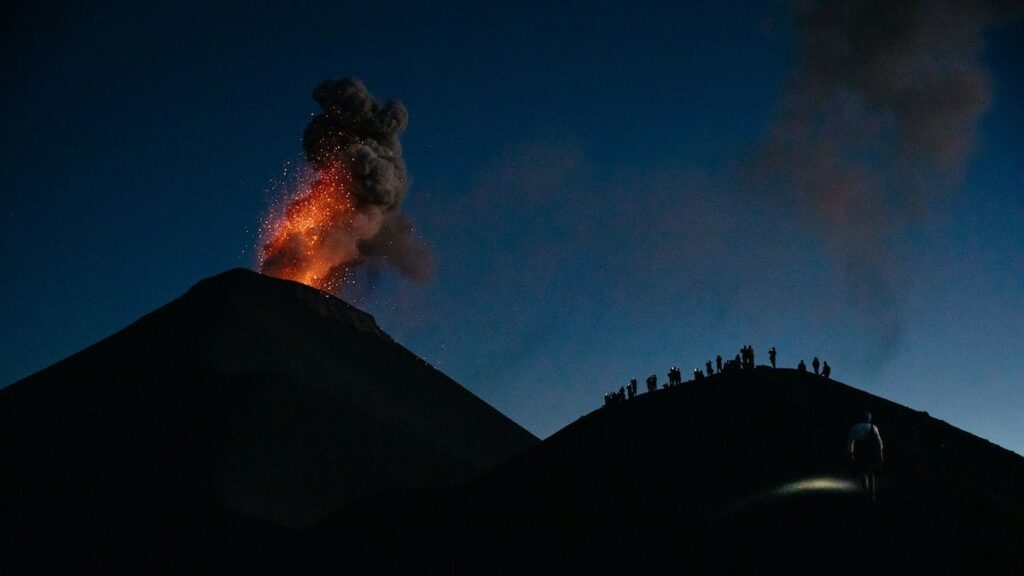Frequent and dramatic eruptions make Guatemala’s 12,346-foot-tall Volcán de Fuego one of the most active volcanoes in the world. Adventurers seeking an up-close encounter with this pyroclastic marvel head to the summit of neighboring Acatenango Volcano—at 13,045 feet, the third highest in Guatemala—which provides an unparalleled vantage point. The strenuous hike goes from lush coffee plantations at the mountain’s base to the cloud forests on the mountainside, up to the otherworldly terrain near the peak. Here’s what to know about this awe-inspiring trek.
One of the world’s most active volcanoes, Volcán de Fuego erupts in the background as hikers tackle Acatenango.
Although challenging, hiking through the lush forests of Acatenango provides a serene escape into nature, surrounded by the sounds of wildlife at every step.
Acclimatize in Antigua
Before embarking on the journey to witness Fuego’s eruptions, acclimatize to the altitude in Antigua Guatemala. Just over an hour west from the country’s capital and sitting in the shadow of volcanoes Agua, Acatenango, and Fuego, the charming colonial town of Antigua has cobblestone streets, vibrant markets, and picturesque plazas.
Hiker Charlie Ballinger reads in his tent with a view of an eruption of Volcán de Fuego as seen from inside camp on Acatenango.
Spending a night at Acatenango’s campsites allows hikers to bond over dinner and share stories under the stars with the glowing silhouette of Volcán de Fuego in the distance.
While exploring this UNESCO World Heritage site, visitors can find local flavors at Café Condesa; experience traditional barbecue and live music at Restaurante Las Antorchas; and absorb the tranquility of the baroque La Merced Church, built in 1767. Accommodations range from the convenient Posada del Angel to the luxurious Casa Santo Domingo, located in a former late-17th-century convent.
Choose a one- or two-day hike
Hikes usually start at the village of La Soledad, where the path to Acatenango begins. From here, climbers can expect a challenging but rewarding ascent, passing through different ecosystems, from farmlands to coniferous forests. The hike to the top can take from 5 to 6 hours, depending on pace and weather conditions. There’s an option to go on horseback for the initial segment of the journey, as the final stretch to the top must be done by foot.
Hiker Zilia Landes heads out from camp on Acatenango.
Seen from Acatenango at sunrise, Volcán de Agua rises some 12,340 feet. Guatemala’s Agua, Fuego, and Acatenango volcanoes are geologically entangled, sharing a common base along the Pacific Ring of Fire, with Fuego’s frequent eruptions potentially influencing seismic activity across the region.
At Acatenango’s crater, amid the clouds and above the canopy, the explosive power of Fuego is on full display. Many adventurers opt for a two-day expedition to be able to overnight at the summit, experiencing the spectacular sights and sounds of glowing lava and pyroclastic material set against the starlit night skies.
Be prepared for a dramatic range in temperatures due to the high elevation, with daytime temperatures over 68°F and below freezing at night. Whereas the two-day hike allows for a paced journey, the Acatenango day trip packs the ascent and descent into a single, more strenuous day. Offered by Casa Santo Domingo and outfitters like Antigua Tours and OX Expeditions, this trip starts early at 5 a.m. to ensure hikers return by dusk, usually taking between 10 to 12 hours, including a shuttle to and from Antigua.
(What you’ll discover on a journey through Guatemala’s Western Highlands.)
What to know
Trekking to Acatenango is not for the faint-hearted. This adventure requires physical fitness, preparation, and a spirit of adventure. Pack warm clothing, sturdy hiking boots, water, and snacks. The dry season, from November to April, typically offers clearer views of the volcano.
The frequent eruptions of Volcán de Fuego occur several times a day.
For safety, it is important to stay informed about the volcano’s activity through official sources, hiring a local guide for the trek, and following the guide’s instructions. Outfitters like OX Expeditions lead overnight hikes that include a bilingual guide, meals, tents, and shuttle to and from Antigua.
Trekkers are encouraged to leave-no-trace and preserve the beauty of this natural wonder.
Seen from Acatenango at sunrise, Volcán de Agua has a water-filled crater and virgin forests, having last erupted in the early Holocene.
Mexican journalist Erick Pinedo is a former editor at the Latin American edition of National Geographic. Follow him on Instagram.
Peter Fisher is a freelance photographer based in Brooklyn, New York. This is his first assignment for National Geographic.
>>> Read full article>>>
Copyright for syndicated content belongs to the linked Source : National Geographic – https://www.nationalgeographic.com/travel/article/safely-hike-acatenango-volcano-guatemala
